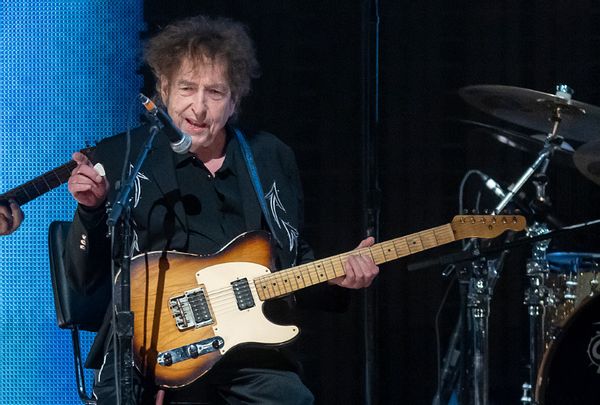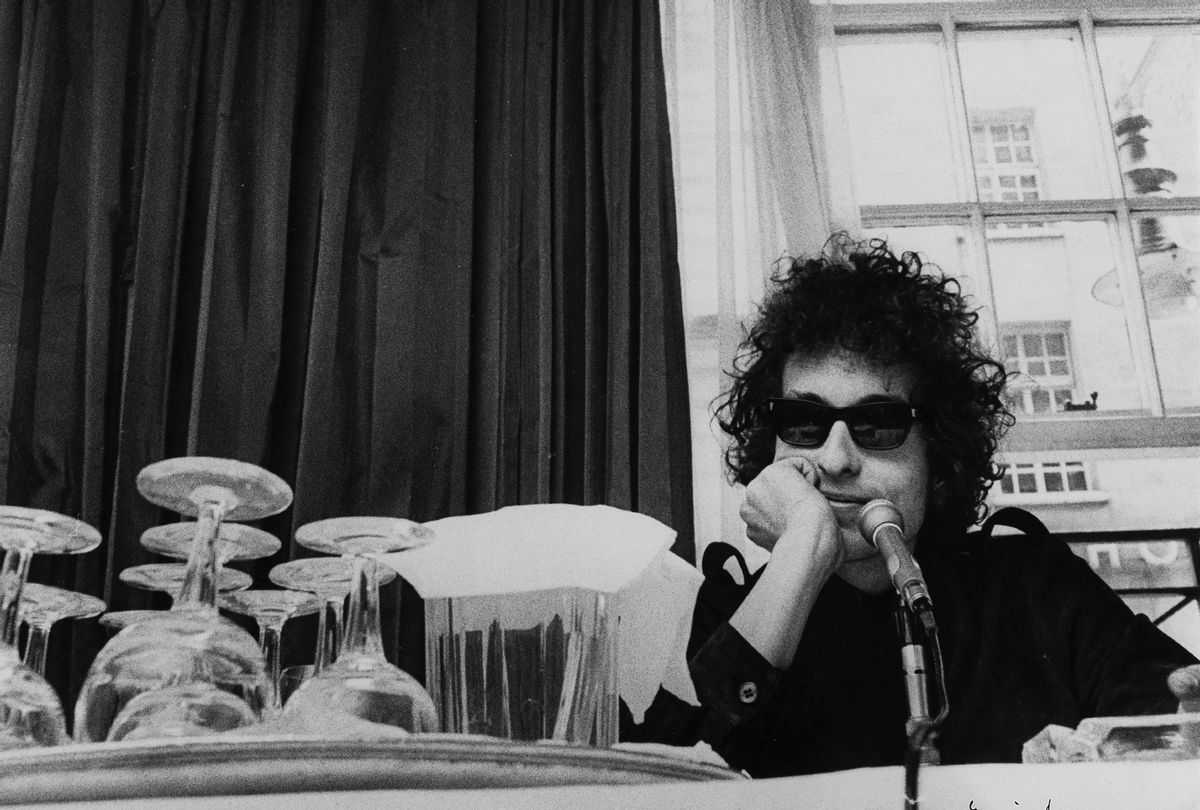The spring edition of Bob Dylan’s "Rough and Rowdy Ways 2025" tour rolled into Kalamazoo, Michigan, on a Wednesday evening in mid-April. Earlier in the month, the tour had visited places like Eau Claire, Wisconsin; Davenport, Iowa; and Omaha, Nebraska.
Dylan does not need to tour. He will be 84 years old in May, has recently sold his songwriting catalog to Universal Music for a rumored $300 million, and if he felt the need to play in front of a live audience, could easily set up shop for a couple of weeks in places like New York, Chicago, or Los Angeles and let the fans come to him — and they happily would.
The only answer to why Dylan is in Kalamazoo (or something similar) is that he wants to be there, playing small to mid-sized audiences in cities and towns that don’t usually get concerts by someone of his stature. The audiences have reciprocated the gesture by filling the theaters more than they usually do. Outside of the major cities, it’s usually not all that hard to find a good ticket to see Dylan.
But this time out — possibly because of a wave of both renewed awareness and maybe some general goodwill thanks to "A Complete Unknown," the film based on Dylan’s early days in New York City — the shows sold briskly and the Bobcats (yes, that is a name used to describe the diehard fans) had to hustle to get into the building this time around.
The only answer to why Dylan is in Kalamazoo (or something similar) is that he wants to be there.
When I arrived around 2:30 p.m. to collect my ticket from will call, I overheard someone in the box office inform a caller that there were only about 30 tickets left, and as I stood waiting my turn, two of those were sold, one to a university student and another to a gray-haired gentleman who arrived on his bike.
Dylan’s been to Kalamazoo six times since 1978 and was last at the 3,500 capacity Miller Theater on the Western Michigan University Campus in 2010. But the city seemed genuinely proud to have Dylan in their midst. The hotel desk clerk mentioned that she’d heard about it on the news, and the venue’s request that attendees show up early in order to get through security was taken seriously, with a line of cars waiting to get into the parking lots an hour before showtime. But perhaps the best indicator of their appreciation was in the fact that the K’zoo audience listened to the music for the entirety of Dylan’s usual 90-minute set with what felt like deep interest and attention.
There were no exoduses out for drinks, disruptive yells for song requests, or even the tried-and-true “I LOVE YOU BOB.” But people in the audience would stand and applaud for particularly notable performances, and not just for the obvious hits. They acknowledged a powerful “Desolation Row,” but also rose to applaud a particularly intense “Black Rider,” from Dylan’s most recent album. The woman who sat next to me, accompanied by her son, asked me, towards the end of the night, what album “Mother of Muses” was on, and if she could purchase it on Amazon.
Want a daily wrap-up of all the news and commentary Salon has to offer? Subscribe to our morning newsletter, Crash Course.
Dylan would even seemingly acknowledge the audience’s response about halfway through the set, saying, “We’re doing all the hits tonight” after “My Own Version of You.” While that’s not strictly true — about half the 17-song set draws from 2020’s "Rough and Rowdy Ways" — that is a lot from a man who isn’t fond of talking much onstage these days.
 Bob Dylan (Gary Miller/Getty Images)Dylan and his band were in particularly sharp form on Wednesday in Kalamazoo, with strong renditions of “When I Paint My Masterpiece” — Dylan's vocal delivery was almost playful — an unexpectedly bubbling “To Be Alone With You,” and his own careful, studied recitation of R&RW’s “Key West” transported you there, or at least into his imagination. “It’s All Over Now, Baby Blue” felt like a gentle croon as compared to the frantic desperation of the original, but still felt decisive. It felt in some ways as though Dylan wanted to reward the audience’s attendance and attention with performances that were easier to comprehend — at least melodically — than previous outings may have been.
Bob Dylan (Gary Miller/Getty Images)Dylan and his band were in particularly sharp form on Wednesday in Kalamazoo, with strong renditions of “When I Paint My Masterpiece” — Dylan's vocal delivery was almost playful — an unexpectedly bubbling “To Be Alone With You,” and his own careful, studied recitation of R&RW’s “Key West” transported you there, or at least into his imagination. “It’s All Over Now, Baby Blue” felt like a gentle croon as compared to the frantic desperation of the original, but still felt decisive. It felt in some ways as though Dylan wanted to reward the audience’s attendance and attention with performances that were easier to comprehend — at least melodically — than previous outings may have been.
The musicians onstage with Bob absolutely deserve praise and attention. Three of the musicians you would have seen him with in 2024 are still around: Tony Garnier on bass and Bob Britt and Doug Lancio on acoustic and/or electric guitar. They arrange themselves facing Bob, who sits at center stage, and do not take their eyes off him for one minute. On the drums currently is Anton Fig, who most people know from his tenure on "The David Letterman Show." He took the place of legendary session drummer and previous Dylan collaborator Jim Keltner, who was in the seat last summer.
You don’t go to a Dylan show in 2025 hoping to hear a rarity, you’re going to spend time in the same space as Bob Dylan.
Bob’s main instrument of choice these days is a grand piano, and sometimes his execution on that is masterful, and other times it feels a little slapdash. But this has been recently augmented with an electric guitar. In 2024, there was always an electric guitar onstage, lying flat on an equipment case against the back wall; it was both frustrating and tantalizing because he could pick it up at any time, and yet sadly, he did not.
But this spring, the guitar was behind the piano within arm’s reach, and there were 2-3 songs in which Dylan did indeed play electric guitar. In Kalamazoo, the audience got to experience this on “I’ll Be Your Baby Tonight,” which opened the show, as well as “It Ain’t Me, Babe” and “Watching the River Flow.” He’s sitting on the piano bench while he’s doing so, which means the only people who can actually see him playing are his band, but you can absolutely hear it, and there is this little frisson of excitement when he does. It sounds different; it feels different, even if just for a split second.
This spring outing has experienced exactly one set change from this outing’s start in Tulsa, Oklahoma at the end of March: he opened with “All Along The Watchtower,” and a week later switched it for “I’ll Be Your Baby Tonight,” which held its place until this run’s end (in Williamsport, PA, on April 22nd). But you don’t go to a Dylan show in 2025 hoping to hear a rarity, you’re going to spend time in the same space as Bob Dylan. The Bobcats have their own reasons for turning up multiple nights and can debate the finer points of, say, the phrasing and delivery of individual lines of songs from night to night. It’s the same set except that it’s never the same set.
But any of this — the set, the instruments, the band members — can change by the time Dylan is back on the road again, this time on the 10th anniversary of the Outlaw Music Festival, once again sharing a stage with Willie Nelson (along with Billy Strings, Sheryl Crow, Nathaniel Rateliff and a whole host of other rotating musicians). They’ll be hitting the road out West in mid-May and continuing across the outdoor amphitheaters of America until the fall.
What changes can an audience expect? Well, for last summer’s Outlaw tour, he changed the entire set, replaced the drummer (Jerry Pentecost, who’d taken the place of Charley Drayton in 2023) with Jim Keltner, and removed a long-time band member (multi-instrumentalist Donnie Herron, who’d been playing with him for 19 years). Anything remains possible with Dylan, which is delightful, improbable for a man of his stature, and yet perfectly in character for the man who changed the face of rock and roll. He’s still doing that.



Shares